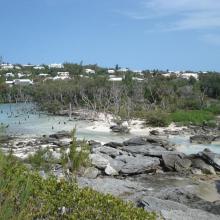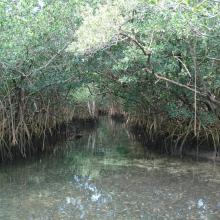

Hungry Bay Mangrove Swamp
- Country:United Kingdom of Great Britain and Northern Ireland (Overseas territories)
- Site number:987
- Area:2.8 ha
- Designation date:11-05-1999
- Coordinates:32°17'N 64°45'W
Materials presented on this website, particularly maps and territorial information, are as-is and as-available based on available data and do not imply the expression of any opinion whatsoever on the part of the Secretariat of the Ramsar Convention concerning the legal status of any country, territory, city or area, or of its authorities, or concerning the delimitation of its frontiers or boundaries.
Overview
The Site is in a shallow tidal bay with a narrow opening to the sea. It represents the largest example of a near-natural, tidal mangrove swamp in Bermuda, and is at the northerly limit in the Atlantic of this habitat type. It has the longest continuous sequence of mangrove peat layers in the Atlantic and provided the first documented evidence of significant forest retreat caused by contemporary sea-level rise. The Site supports a diverse assemblage of mangrove and associated species. They include both red mangrove (Rhizophora mangle) and black mangrove (Avicennia germinans), and the largest Bermudian populations of the giant land crab (Cardisoma guanhumi) and the land hermit crab (Coenobita clypeatus), which are listed as vulnerable on the Bermuda Protected Species Order of 2012. It is a valuable wintering location for various migrant bird species, as a breeding site for resident herons and Bermuda white-eyed vireo (Vireo griseus bermudianus), and as a spawning ground for several commercially important fish species. Erosion is a major threat, which is exacerbated by the increasing frequency and intensity of tropical cyclones. In addition, large amounts of floating debris are blown and washed into the Site from the ocean. The Site serves as an educational resource and is the subject of a long-running mangrove monitoring study. Public access is limited, with only two access points which are distant from the mangrove. There is limited recreational use of channels in the mangrove by snorkelers, kayakers and paddleboarders.
Administrative region:
Paget Parish, Bermuda
- National legal designation:
- Nature Reserve under Bermuda National Parks Act 1986 - Hungry Bay Nature Reserve
- Last publication date:10-01-2024
Downloads
Ramsar Information Sheet (RIS)
Archived RIS
Additional reports and documents
- Other published literature
